Papers by IAEES Publications
Selforganizology, 2025
A calculator, probTable, was developed for lookuping probability tables. In the calculator, proba... more A calculator, probTable, was developed for lookuping probability tables. In the calculator, probability distributions as normal distribution, t distribution, F distribution, χ2 distribution, Weibull distribution, lognormal distribution, binomial distribution, Poission distribution, negative binomial distribution, and uniform distribution, etc., were available for use. Probability density function, cumulative distribution function, and inverse cumulative distribution function of these probability distributions can be calculated. The calculator was developed as a standalone software using Matlab. Full codes and software were provided.
http://www.iaees.org/publications/journals/selforganizology/articles/2025-12(3-4)/1-Zhang-Abstract.asp
Computational Ecology and Software, 2025
A calculator, probDistriCal, was developed for probability distributions. In the calculator, the ... more A calculator, probDistriCal, was developed for probability distributions. In the calculator, the probability distributions as normal distribution, t distribution, F distribution, χ2 distribution, exponential distribution, power law distribution, Weibull distribution, Zhang distribution, binomial distribution, Poission distribution, and negative binomial distribution, etc., were available for use. Given a random value, the corresponding probability for a selected probability distribution can be calculated. The calculator is web browser based that includes both online and offline versions and can be used on various computing devices (PCs, iPads, smartphones, etc.), operating systems (Windows, Mac, Android, Harmony, etc.) and web browsers (Chrome, Firefox, etc).
http://www.iaees.org/publications/journals/ces/articles/2025-15(2)/probDistriCal.htm
Network Biology, 2025
Mendelian randomization (MR) is a methodology for evaluating causality in observational studies. ... more Mendelian randomization (MR) is a methodology for evaluating causality in observational studies. MR tries to find the fact that genotypes are not susceptible to reverse causation and confounding based on Mendel's law of inheritance. MR may provide information on causality in situations where randomized controlled trials are impossible. In present article, the principles and methods of MR were fully discussed.
http://www.iaees.org/publications/journals/nb/articles/2025-15(2)/1-Zhang-Abstract.asp

Proceedings of the International Academy of Ecology and Environmental Sciences, 2024
Proceedings of the International Academy of Ecology and Environmental Sciences (ISSN 2220-8860; C... more Proceedings of the International Academy of Ecology and Environmental Sciences (ISSN 2220-8860; CODEN PIAEBW)
E-mail: piaees@iaees.org
Volume 14, Number 3, 1 September 2024
http://www.iaees.org/publications/journals/piaees/articles/2024-14(3)/2024-14(3).asp
Cover Pages
[Front Pages (187K)] [Back Pages (78K)]
Articles
Elytron shape variability among selected synanthropic beetles from Southern Philippines
Proceedings of the International Academy of Ecology and Environmental Sciences, 2024, 14(3): 86-94
Ernel D. Bagbag, Cesar G. Demayo, Mark Anthony J. Torres
[Abstract] [XML] [EndNote] [RefManager] [BibTex] [PubMed]
[ Full PDF (206K)]
[Email Article] [Comment/Review Article]
Ecotourism potentials and its challenges in Dhati Walal National Park, West Ethiopia
Proceedings of the International Academy of Ecology and Environmental Sciences, 2024, 14(3): 95-107
Alemayehu Mamo, Yohannes Shifera, Kenasa Degefa, Zelalem Telila
[Abstract] [XML] [EndNote] [RefManager] [BibTex] [PubMed]
[ Full PDF (350K)]
[Email Article] [Comment/Review Article]
First record of Muscicapa striata Pallas 1764 (Passeriformes: Muscicapidae) from Nanda Devi Biosphere Reserve, India with evidence of a photographic plate
Proceedings of the International Academy of Ecology and Environmental Sciences, 2024, 14(3): 108-114
Kanchan Puri, Ritesh Joshi, Raju Pushola
[Abstract] [XML] [EndNote] [RefManager] [BibTex] [PubMed]
[ Full PDF (205K)]
[Email Article] [Comment/Review Article]
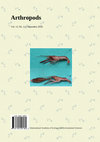
Arthropods, 2024
Arthropods (ISSN 2224-4255)
E-mail: arthropods@iaees.org
Volume 13, Number 3, 1 September 2024 ... more Arthropods (ISSN 2224-4255)
E-mail: arthropods@iaees.org
Volume 13, Number 3, 1 September 2024
http://www.iaees.org/publications/journals/arthropods/articles/2024-13(3)/2024-13(3).asp
Cover Pages
[Front Pages (165K)] [Back Pages (55K)]
Articles
First record of Alpheus leptocheles Banner and Banner, 1975 (Crustacea, Alpheidae) in southeast coast of India
Arthropods, 2024, 13(3): 104-111
Mandal Kajal, Muthusamy Thangaraj
[Abstract] [XML] [EndNote] [RefManager] [BibTex] [DOAJ] [PubMed]
[ Full PDF (146K)]
[Email Article] [Comment/Review Article]
Lepidopteran insect pests of Elaeocarpus angustifolius Bl. in nursery
Arthropods, 2024, 13(3): 112-119
Pooja Singh, A. N. Singh
[Abstract] [XML] [EndNote] [RefManager] [BibTex] [DOAJ] [PubMed]
[ Full PDF (522K)]
[Email Article] [Comment/Review Article]
Biodiversity of aphidophagous predators in Ayodhya district, Uttar Pradesh, India
Arthropods, 2024, 13(3): 120-156
Krishna Manohar Tiwari, Prem Narayan Tripathi, Rajendra Singh
[Abstract] [XML] [EndNote] [RefManager] [BibTex] [DOAJ] [PubMed]
[ Full PDF (273K)]
[Email Article] [Comment/Review Article]
Computational Ecology and Software, 2024
In present study a method that enables users to dynamically insert the forest plot into a web pag... more In present study a method that enables users to dynamically insert the forest plot into a web page was presented. In this method, I created a Javascript module for generating and inserting a HTML table, including an entry function and two sub-functions. When the user applies it, copy these functions together with the table mark into the web page location where the forest plot is to be inserted. The web page will generate the forest plot by passing in parameters and calling the entry function in the user's own Javascript module. The full Javascript codes were given for free uses of web developers.
http://www.iaees.org/publications/journals/ces/articles/2024-14(3)/1-Zhang-Abstract.asp
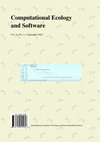
Computational Ecology and Software, 2024
Computational Ecology and Software (ISSN 2220-721X)
E-mail: ces@iaees.org
Volume 14, Number 3, ... more Computational Ecology and Software (ISSN 2220-721X)
E-mail: ces@iaees.org
Volume 14, Number 3, 1 September 2024
http://www.iaees.org/publications/journals/ces/articles/2024-14(3)/2024-14(3).asp
Cover Pages
[Front Pages (81K)] [Back Pages (59K)]
Articles
Dynamically insert the forest plot into a web page: The full Javascript codes
Computational Ecology and Software, 2024, 14(3): 168-173
WenJun Zhang, GuangHua Liu
[Abstract] [XML] [EndNote] [RefManager] [BibTex] [DOAJ]
[ Full PDF (638K)]
[Email Article] [Comment/Review Article]
Geometric morphometric analysis describing sexual dimorphism in housefly, Musca domestica Linn. (Diptera: Muscidae)
Computational Ecology and Software, 2024, 14(3): 174-185
Ernel D. Bagbag, Helen B. Pondevida
[Abstract] [XML] [EndNote] [RefManager] [BibTex] [DOAJ]
[ Full PDF (383K)]
[Email Article] [Comment/Review Article]
Multi-objective mathematical programming subject to box boundary constraints on system parameters
Computational Ecology and Software, 2024, 14(3): 186-204
H. Khoder
[Abstract] [XML] [EndNote] [RefManager] [BibTex] [DOAJ]
[ Full PDF (926K)]
[Email Article] [Comment/Review Article]
Status and distribution of African elephant (Loxodonta africana) in Eastern Africa
Computational Ecology and Software, 2024, 14(3): 205-214
Aster Arefaine Gebrehiwet, Gebre Gidey Weldeabzgi
[Abstract] [XML] [EndNote] [RefManager] [BibTex] [DOAJ]
[ Full PDF (262K)]
[Email Article] [Comment/Review Article]
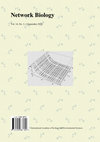
Network Biology, 2024
Network Biology (ISSN 2220-8879; CODEN NBEICS)
E-mail: networkbiology@iaees.org
Volume 14, Numb... more Network Biology (ISSN 2220-8879; CODEN NBEICS)
E-mail: networkbiology@iaees.org
Volume 14, Number 3, 1 September 2024
http://www.iaees.org/publications/journals/nb/articles/2024-14(3)/2024-14(3).asp
Cover Pages
[Front Pages (154K)] [Back Pages (70K)]
Articles
Stability analysis of a predator-prey model using Takagi-Sugeno method
Network Biology, 2024, 14(3): 215-227
Kaladhar Kolla, Khushbu Singh
[Abstract] [XML] [EndNote] [RefManager] [BibTex] [DOAJ] [PubMed]
[ Full PDF (2511K)]
[Email Article] [Comment/Review Article]
Dynamical behavior of an eco-epidemiological model incorporating Holling type-II functional response with prey refuge and constant prey harvesting
Network Biology, 2024, 14(3): 228-241
P. Sireeshadevi, G. Ranjith Kumar
[Abstract] [XML] [EndNote] [RefManager] [BibTex] [DOAJ] [PubMed]
[ Full PDF (1061K)]
[Email Article] [Comment/Review Article]
Analysis of amino acids network based on graph mining
Network Biology, 2024, 14(3): 242-253
Nasrin Irshad Hussain, Kuntala Boruah
[Abstract] [XML] [EndNote] [RefManager] [BibTex] [DOAJ] [PubMed]
[ Full PDF (774K)]
[Email Article] [Comment/Review Article]
Selforganizology, 2024
Selforganizology (ISSN 2410-0080)
E-mail: selforganizology@iaees.org
Volume 11, Number 3-4, 1 ... more Selforganizology (ISSN 2410-0080)
E-mail: selforganizology@iaees.org
Volume 11, Number 3-4, 1 December 2024
http://www.iaees.org/publications/journals/selforganizology/articles/2024-11(3-4)/2024-11(3-4).asp
Cover Pages
[Front Pages (92K)] [Back Pages (77K)]
Articles
objectVisual3D: A standalone executable software for 3D visualization of objects
Selforganizology, 2024, 11(3-4): 28-53
WenJun Zhang
[Abstract] [XML] [EndNote] [RefManager] [BibTex] [DOAJ]
[ Full PDF (759K)][Supplementary Material (916K)]
[Email Article] [Comment/Review Article]
An interactive interior point method for mathematical multi-objective linear optimization problems based on approximate gradients
Selforganizology, 2024, 11(3-4): 54-75
M. Tlas
[Abstract] [XML] [EndNote] [RefManager] [BibTex] [DOAJ]
[ Full PDF (819K)]
[Email Article] [Comment/Review Article]
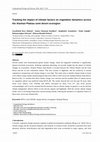
Computational Ecology and Software, 2024
Several studies have demonstrated global climate change, which has happened worldwide; it signifi... more Several studies have demonstrated global climate change, which has happened worldwide; it significantly impacts terrestrial ecosystems. Studying vegetation phenology can provide insight into the impact of climate changes on ecosystems. Alashan Plateau Semi-Desert is located between the Tibetan Plateau and the Gobi Desert and has an arid continental climate. This area consists of highlands, and the sensitivity of natural vegetation to temperature and climate change is very high. This study aims to identify climate trends in forest cover indices using weather (meteorological) data from 1982 to 2019 across the Alashan Plateau Semi-Desert. Based on this, 13 variables that affect climate change were selected, and the possible effect of climate factors on vegetation indices was predicted using MATLAB. The results showed that over the past 38 years, three forest cover indices, LAI, FAPAR, and NDVI, decreased by about 6-10, 6-7, and 19-20 percent correspondingly, and it can be assumed that this decline is due to climate change. In general, it can be said that climate changeshave adverse effects in hot and dry regions and highlands. With the current climate change trends, such as increasing temperature and decreasing rainfall, reducing the dynamics of vegetation indices in these areas can be seen dramatically.
http://www.iaees.org/publications/journals/ces/articles/2024-14(2)/1-Shobairi-Abstract.asp
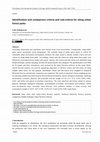
Proceedings of the International Academy of Ecology and Environmental Sciences, 2024
Increasing urbanization and population take humans away from environment. Consequently, siting pu... more Increasing urbanization and population take humans away from environment. Consequently, siting public green spaces necessitates social requirements. The scientific siting of public green spaces is critical for sustainable urban environment development, therefore this study aimed to identify suitable criteria and subcriteria for siting urban forest parks. Accordingly, criteria and sub-criteria for siting urban forest parks were defined by reviewing previous studies and experts' opinion. The criteria and sub-criteria were identified using Delphi technique, random sampling, and then the questionnaires were designed. The questionnaires were filled by 10 experts and their consistencies were assessed by the Super Decision software. In this study, Multicriteria decision analysis was used for appointing importance of effective criteria and sub-criteria on siting suitable urban forest. For this purpose, determinant criteria and sub-criteria were weighted in Analytical Hierarchy Process, and pairwise comparison was conducted. The results of important criteria weighing process for selecting suitable forest park location showed that environmental, natural, biological community, landscape, sociocultural, economic, physical, and accessible with the weight of 0.
http://www.iaees.org/publications/journals/piaees/articles/2024-14(2)/4-Ooshaksaraie-Abstract.asp
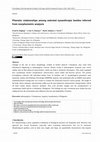
Proceedings of the International Academy of Ecology and Environmental Sciences, 2024
Changes in the size of insect morphology, notably in beetles (Insecta: Coleoptera), may come from... more Changes in the size of insect morphology, notably in beetles (Insecta: Coleoptera), may come from disturbances happening in anthropogenic contexts. Beetles living in anthropogenic situations may evolve similar sizes in their physical characteristics, which can lead to systematic discrepancy. This study examined how synanthropic beetles' morphometric characteristics varied within and between species. The present investigation collected 149 individual beetles from 18 families, and 11 morphological parameters were measured. Adonis and Similarity Percentage (SIMPER) analyses were performed after an NMDS (non-metric multidimensional scaling) plot was created to evaluate the similarities between various groups. The length of the body, elytra, antennae, and pronotum width were the most distinctive characteristics among beetles, which all share similar shorter character attributes. This work provides insights into the morphometrics of synanthropic beetle species in Mindanao, Philippines. The findings not only corroborate prior studies but also emphasize how the environment may influences the size and adaptability of beetles.
http://www.iaees.org/publications/journals/piaees/articles/2024-14(2)/2-Bagbag-Abstract.asp
Arthropods, 2024
Three specimens of Audacallichirus audax (de Man, 1911)were collected from Mudasal Odai (11°29'06... more Three specimens of Audacallichirus audax (de Man, 1911)were collected from Mudasal Odai (11°29'06"N 79°46'28"E) fish landing center, Tamil Nadu, Southeastern coast of India in August 2022 and June 2023. The species was recognised by key characters and colour pattern. The identification is further confirmed by 16S rRNA gene sequences. This is the first record from southeast India, outside their known geographical range which is a range extension within the Indian coastal region. Keywords by-catch; ghost shrimp; Audacallichirus audax;new record; Southeast India.
http://www.iaees.org/publications/journals/arthropods/articles/2024-13(2)/1-Thangaraj-Abstract.asp
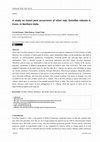
Arthropods, 2024
Silver oak, Grevillea robusta A. Cunn. is an important exotic tree species component of urban for... more Silver oak, Grevillea robusta A. Cunn. is an important exotic tree species component of urban forestry in India. However, the occurrence of insect-pests in exotics causes tremendous impact on the production and yield in nurseries as well-established plantations; consequently, reducing profits and inducing high expense to stakeholders. Thus, a detailed account of insect-pests infestation and their impact becomes important. Therefore, present study was undertaken to find out the insect pest occurrence on G. robusta in the nursery, plantation established at different geographical region of northern India from 2018-2022. The study result exhibited infestation of ten insect-pests for the first time on G. robusta. Six species were defoliator in nature viz. Ascotis selenaria, Chrysodeixis includens, Ectropis bhurmitra, Helicoverpa armigera, Hyposidra talaca, and Olene inclusa; while infestation of four species of sap sacking nature viz. Asterolecanium sp., Ceroplastes rusci, Drosicha stebbingi, and Oxyrachis tarandus. The seasonal incidence and nature of damage were also recorded for the first time of these insects on G. robusta. This is the first attempt to report insect-pests of G. robusta, which gave an overview of the possible potential threat in India. The study would be beneficial for future reference with respect to pest management of G. robusta, when the species is taken up for tree improvement program in the long run.
http://www.iaees.org/publications/journals/arthropods/articles/2024-13(2)/3-Kumar-Abstract.asp
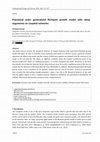
Computational Ecology and Software, 2024
This study aims to examine the dynamical behavior of Caputo fractional order generalized Richards... more This study aims to examine the dynamical behavior of Caputo fractional order generalized Richards growth model with delay. In order to transition from continuous time model to a discrete version, piecewise constant arguments are added to the model and thus system of difference equation are obtained from the solutions of the model in the sub-intervals. We obtain an algebraic condition where the positive equilibrium point of the discrete model with respect to changing parameter r is locally asymptotically stable. Moreover, it has been theoretically proven that the Neimark-Sacker bifurcation occurs at the positive equilibrium point of the discrete system and the direction of this bifurcation has been determined. In addition, discretized generalized Richards growth model is also considered on the globally coupled network with N=10 nodes. Numerical simulations have revealed that thecoupling strength parameter c plays a key role in the dynamical behavior of the node with the highest degree in such a complex network. Numerical simulations are performed to demonstrate the stability, bifurcations and dynamic transition of the coupled network.
http://www.iaees.org/publications/journals/ces/articles/2024-14(2)/4-Kartal-Abstract.asp
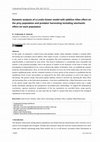
Computational Ecology and Software, 2024
In this study, we proposed a Leslie-Gower prey-predator model, whose dynamics includes a constant... more In this study, we proposed a Leslie-Gower prey-predator model, whose dynamics includes a constant effort harvesting rate in predators and an additive Allee impact on prey. A system of stochastic differential equations is also used to study its behaviour, with the assumption that each population's exposure to environmental unpredictability is represented by noise terms. This kind of randomness is considerably more reasonable and realistic in the proposed paradigm. Due to the paucity of studies on the dynamics of this kind of model, this investigation is being believed to be a way to advance the subject of literature. First, we establish the system's positivity and boundlessness. Next, we look into the dynamics of every one of the stable states, the form of the positive equilibrium point, and the continued existence of every species in the system.It is established that the equilibrium levels of prey and predator are impacted by the Allee effect parameter as well as the impact of harvesting. The positive steady state point's global stability criterion is derived. By selecting the Allee effect and harvesting effort as the bifurcation parameters, it has been established that a Hopf bifurcation exists close to the interior steady state.This study is novel since it incorporates various ecological factors into a single model, potentially opening up new perspectives on predator-prey relationships. To support the mathematical conclusions, rigorous numerical visualisations of the key parameters are provided below using specific hypothetical data. In conclusion, we may state that our model is a project that aims to preserve the ecological equilibrium of the natural world.
http://www.iaees.org/publications/journals/ces/articles/2024-14(2)/2-Ramesh-Abstract.asp
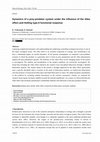
Network Biology, 2024
Capturing complicated dynamics and understanding the underlying controlling ecological processes ... more Capturing complicated dynamics and understanding the underlying controlling ecological processes is one of the major ecological issues. The Allee effect is an essential component in ecology, and considering it can have a substantial impact on system dynamics. In the present investigation, we analysed a prey-predator scenario in which the predator is a generalist since it feeds on prey populations and the Allee phenomenon impacts the prey population's growth. The influence of the Allee effect on the changing nature of the system is investigated. The stability and boundedness of the model's equilibria are extensively investigated. We found that including the Allee effect enhances the system's local and global behaviours through a detailed bifurcation analysis. The chaotic nature of the system is strongly impacted by the Allee effect, particularly once a specific threshold value is reached. In the study of bifurcation analysis, we looked into bifurcations such the presence of transcritical bifurcation and Hopf-bifurcation to chaos. We added stochastic perturbation to this problem by including random fluctuations in the sensitive parameters. Finally, we analysed the system's mean-square stochastic stability towards the internal equilibrium. As a result, it is discovered that the Allee effect and stochastic perturbation considerably influence the behaviour of the prey-predator system.
http://www.iaees.org/publications/journals/nb/articles/2024-14(2)/7-Ramesh-Abstract.asp
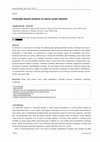
Network Biology, 2024
A network is a crucial asset in biology for capturing and exploring interaction data in biologica... more A network is a crucial asset in biology for capturing and exploring interaction data in biological systems of many types, such as protein-protein communications, amino acid associations, gene regulation, and cellular metabolism. In this article, we constructed an amino acid distance matrix by considering each base's positional relevance in a codon, chemical types: Purine and Pyrimidine, and H-bonding count. Based on the amino acid distance matrix, we eventually generated a twenty amino acid network having evolutionary significance. We reviewed multiple centrality metrics to assess the relative importance of amino acids in the proposed network: Degree Centrality, Closeness Centrality, Betweenness Centrality, Eigenvector Centrality, Eccentricity Centrality, and Radiality Centrality. We also looked at the correlation coefficients between the different centrality measures to figure out whether the network is assortative or disassortative. Furthermore, we examined the Clustering Coefficient and Degree Distribution as two effective network measures, and the results seem noteworthy.
http://www.iaees.org/publications/journals/nb/articles/2024-14(2)/6-Borah-Abstract.asp
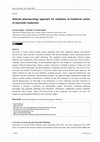
Network Biology, 2024
Ayurveda, an ancient holistic healing system originating from India emphasizes balance and harmon... more Ayurveda, an ancient holistic healing system originating from India emphasizes balance and harmony between body, mind, and spirit. Ayurvedic medicines offer diverse therapeutic claims, spanning preventive care, disease treatment, and overall well-being. This traditional system significantly influences global healthcare and complements modern medicine. However, scientific validation of Ayurvedic claims remains a challenge. Network pharmacology, an interdisciplinary approach, has emerged as a promising tool for this purpose. Network pharmacology explores complex interactions in biological systems. It aligns well with Ayurveda's holistic philosophy and offers potential in validating Ayurvedic medicines. This review covers successful case studies of justification of Ayurvedic claims using network pharmacology approach. We further outlined key steps for such validation, including literature review, compound identification, data collection, network construction, and enrichment analysis. The approach aligns traditional knowledge with modern scientific findings, enhancing the credibility of both. The integration of Ayurvedic principles with network pharmacology can shed light on the mechanisms of action underlying Ayurvedic medicines. In conclusion, network pharmacology holds immense potential in validating the traditional claims of Ayurvedic medicines. It provides a framework for understanding complex interactions, confirming traditional knowledge, and potentially unlocking novel therapeutic mechanisms. Collaboration between traditional practitioners and scientists, along with advancements in data integration and analysis, can drive this integration, enriching global healthcare with Ayurvedic insights.
http://www.iaees.org/publications/journals/nb/articles/2024-14(2)/4-Ingale-Abstract.asp

Uploads
Papers by IAEES Publications
http://www.iaees.org/publications/journals/selforganizology/articles/2025-12(3-4)/1-Zhang-Abstract.asp
http://www.iaees.org/publications/journals/ces/articles/2025-15(2)/probDistriCal.htm
http://www.iaees.org/publications/journals/nb/articles/2025-15(2)/1-Zhang-Abstract.asp
E-mail: piaees@iaees.org
Volume 14, Number 3, 1 September 2024
http://www.iaees.org/publications/journals/piaees/articles/2024-14(3)/2024-14(3).asp
Cover Pages
[Front Pages (187K)] [Back Pages (78K)]
Articles
Elytron shape variability among selected synanthropic beetles from Southern Philippines
Proceedings of the International Academy of Ecology and Environmental Sciences, 2024, 14(3): 86-94
Ernel D. Bagbag, Cesar G. Demayo, Mark Anthony J. Torres
[Abstract] [XML] [EndNote] [RefManager] [BibTex] [PubMed]
[ Full PDF (206K)]
[Email Article] [Comment/Review Article]
Ecotourism potentials and its challenges in Dhati Walal National Park, West Ethiopia
Proceedings of the International Academy of Ecology and Environmental Sciences, 2024, 14(3): 95-107
Alemayehu Mamo, Yohannes Shifera, Kenasa Degefa, Zelalem Telila
[Abstract] [XML] [EndNote] [RefManager] [BibTex] [PubMed]
[ Full PDF (350K)]
[Email Article] [Comment/Review Article]
First record of Muscicapa striata Pallas 1764 (Passeriformes: Muscicapidae) from Nanda Devi Biosphere Reserve, India with evidence of a photographic plate
Proceedings of the International Academy of Ecology and Environmental Sciences, 2024, 14(3): 108-114
Kanchan Puri, Ritesh Joshi, Raju Pushola
[Abstract] [XML] [EndNote] [RefManager] [BibTex] [PubMed]
[ Full PDF (205K)]
[Email Article] [Comment/Review Article]
E-mail: arthropods@iaees.org
Volume 13, Number 3, 1 September 2024
http://www.iaees.org/publications/journals/arthropods/articles/2024-13(3)/2024-13(3).asp
Cover Pages
[Front Pages (165K)] [Back Pages (55K)]
Articles
First record of Alpheus leptocheles Banner and Banner, 1975 (Crustacea, Alpheidae) in southeast coast of India
Arthropods, 2024, 13(3): 104-111
Mandal Kajal, Muthusamy Thangaraj
[Abstract] [XML] [EndNote] [RefManager] [BibTex] [DOAJ] [PubMed]
[ Full PDF (146K)]
[Email Article] [Comment/Review Article]
Lepidopteran insect pests of Elaeocarpus angustifolius Bl. in nursery
Arthropods, 2024, 13(3): 112-119
Pooja Singh, A. N. Singh
[Abstract] [XML] [EndNote] [RefManager] [BibTex] [DOAJ] [PubMed]
[ Full PDF (522K)]
[Email Article] [Comment/Review Article]
Biodiversity of aphidophagous predators in Ayodhya district, Uttar Pradesh, India
Arthropods, 2024, 13(3): 120-156
Krishna Manohar Tiwari, Prem Narayan Tripathi, Rajendra Singh
[Abstract] [XML] [EndNote] [RefManager] [BibTex] [DOAJ] [PubMed]
[ Full PDF (273K)]
[Email Article] [Comment/Review Article]
http://www.iaees.org/publications/journals/ces/articles/2024-14(3)/1-Zhang-Abstract.asp
E-mail: ces@iaees.org
Volume 14, Number 3, 1 September 2024
http://www.iaees.org/publications/journals/ces/articles/2024-14(3)/2024-14(3).asp
Cover Pages
[Front Pages (81K)] [Back Pages (59K)]
Articles
Dynamically insert the forest plot into a web page: The full Javascript codes
Computational Ecology and Software, 2024, 14(3): 168-173
WenJun Zhang, GuangHua Liu
[Abstract] [XML] [EndNote] [RefManager] [BibTex] [DOAJ]
[ Full PDF (638K)]
[Email Article] [Comment/Review Article]
Geometric morphometric analysis describing sexual dimorphism in housefly, Musca domestica Linn. (Diptera: Muscidae)
Computational Ecology and Software, 2024, 14(3): 174-185
Ernel D. Bagbag, Helen B. Pondevida
[Abstract] [XML] [EndNote] [RefManager] [BibTex] [DOAJ]
[ Full PDF (383K)]
[Email Article] [Comment/Review Article]
Multi-objective mathematical programming subject to box boundary constraints on system parameters
Computational Ecology and Software, 2024, 14(3): 186-204
H. Khoder
[Abstract] [XML] [EndNote] [RefManager] [BibTex] [DOAJ]
[ Full PDF (926K)]
[Email Article] [Comment/Review Article]
Status and distribution of African elephant (Loxodonta africana) in Eastern Africa
Computational Ecology and Software, 2024, 14(3): 205-214
Aster Arefaine Gebrehiwet, Gebre Gidey Weldeabzgi
[Abstract] [XML] [EndNote] [RefManager] [BibTex] [DOAJ]
[ Full PDF (262K)]
[Email Article] [Comment/Review Article]
E-mail: networkbiology@iaees.org
Volume 14, Number 3, 1 September 2024
http://www.iaees.org/publications/journals/nb/articles/2024-14(3)/2024-14(3).asp
Cover Pages
[Front Pages (154K)] [Back Pages (70K)]
Articles
Stability analysis of a predator-prey model using Takagi-Sugeno method
Network Biology, 2024, 14(3): 215-227
Kaladhar Kolla, Khushbu Singh
[Abstract] [XML] [EndNote] [RefManager] [BibTex] [DOAJ] [PubMed]
[ Full PDF (2511K)]
[Email Article] [Comment/Review Article]
Dynamical behavior of an eco-epidemiological model incorporating Holling type-II functional response with prey refuge and constant prey harvesting
Network Biology, 2024, 14(3): 228-241
P. Sireeshadevi, G. Ranjith Kumar
[Abstract] [XML] [EndNote] [RefManager] [BibTex] [DOAJ] [PubMed]
[ Full PDF (1061K)]
[Email Article] [Comment/Review Article]
Analysis of amino acids network based on graph mining
Network Biology, 2024, 14(3): 242-253
Nasrin Irshad Hussain, Kuntala Boruah
[Abstract] [XML] [EndNote] [RefManager] [BibTex] [DOAJ] [PubMed]
[ Full PDF (774K)]
[Email Article] [Comment/Review Article]
E-mail: selforganizology@iaees.org
Volume 11, Number 3-4, 1 December 2024
http://www.iaees.org/publications/journals/selforganizology/articles/2024-11(3-4)/2024-11(3-4).asp
Cover Pages
[Front Pages (92K)] [Back Pages (77K)]
Articles
objectVisual3D: A standalone executable software for 3D visualization of objects
Selforganizology, 2024, 11(3-4): 28-53
WenJun Zhang
[Abstract] [XML] [EndNote] [RefManager] [BibTex] [DOAJ]
[ Full PDF (759K)][Supplementary Material (916K)]
[Email Article] [Comment/Review Article]
An interactive interior point method for mathematical multi-objective linear optimization problems based on approximate gradients
Selforganizology, 2024, 11(3-4): 54-75
M. Tlas
[Abstract] [XML] [EndNote] [RefManager] [BibTex] [DOAJ]
[ Full PDF (819K)]
[Email Article] [Comment/Review Article]
http://www.iaees.org/publications/journals/np/articles/2017-2(2)/e-suppl/1-Zhang-Supplementary-Material-2.pdf
Network pharmacology of medicinal attributes and functions of Chinese herbal medicines: (I) Basic statistics of medicinal attributes and functions for more than 1100 Chinese herbal medicines
http://www.iaees.org/publications/journals/np/articles/2017-2(2)/basic-statistics-of-medicinal-attributes-and-functions.pdf
中草藥屬性與功效網絡藥理學: (II) 中草藥屬性與功效關系網絡及藥理機制
http://www.iaees.org/publications/journals/np/articles/2017-2(2)/e-suppl/2-Zhang-Supplementary-Material.pdf
Network pharmacology of medicinal attributes and functions of Chinese herbal medicines: (II) Relational networks and pharmacological mechanisms of medicinal attributes and functions of Chinese herbal medicines
http://www.iaees.org/publications/journals/np/articles/2017-2(2)/networks-and-mechanisms-of-medicinal-attributes-and-functions.pdf
中草藥屬性與功效網絡藥理學: (III) 中草藥屬性類間典範相關函數及線性特征模型
http://www.iaees.org/publications/journals/np/articles/2017-2(3)/e-suppl/1-Zhang-Supplementary-Material.pdf
Network pharmacology of medicinal attributes and functions of Chinese herbal medicines: (III) Canonical correlation functions between attribute classes and linear eignmodels of Chinese herbal medicines
http://www.iaees.org/publications/journals/np/articles/2017-2(3)/canonical-correlation-functions-between-attribute-classes.pdf
中草藥屬性與功效網絡藥理學: (IV) 中草藥功效屬性分類與網絡分析
http://www.iaees.org/publications/journals/np/articles/2017-2(3)/e-suppl/2-Zhang-Supplementary-Material-1.pdf
Network pharmacology of medicinal attributes and functions of Chinese herbal medicines: (IV) Classification and network analysis of medicinal functions of Chinese herbal medicines
http://www.iaees.org/publications/journals/np/articles/2017-2(3)/classification-and-network-analysis-of-medicinal-functions.pdf
哪些科的種子植物入選中草藥的潛力更大?
https://mp.weixin.qq.com/s/D_3qpI42LMkiHgC20byQuw
Naturalness and preference for species selection of Chinese medicinal seed plants
http://www.iaees.org/publications/journals/np/articles/2019-4(1-2)/naturalness-and-preference-for-species-selection-of-Chinese-medicinal-plants.pdf
http://www.iaees.org/publications/journals/ces/articles/2024-14(2)/1-Shobairi-Abstract.asp
http://www.iaees.org/publications/journals/piaees/articles/2024-14(2)/4-Ooshaksaraie-Abstract.asp
http://www.iaees.org/publications/journals/piaees/articles/2024-14(2)/2-Bagbag-Abstract.asp
http://www.iaees.org/publications/journals/arthropods/articles/2024-13(2)/1-Thangaraj-Abstract.asp
http://www.iaees.org/publications/journals/arthropods/articles/2024-13(2)/3-Kumar-Abstract.asp
http://www.iaees.org/publications/journals/ces/articles/2024-14(2)/4-Kartal-Abstract.asp
http://www.iaees.org/publications/journals/ces/articles/2024-14(2)/2-Ramesh-Abstract.asp
http://www.iaees.org/publications/journals/nb/articles/2024-14(2)/7-Ramesh-Abstract.asp
http://www.iaees.org/publications/journals/nb/articles/2024-14(2)/6-Borah-Abstract.asp
http://www.iaees.org/publications/journals/nb/articles/2024-14(2)/4-Ingale-Abstract.asp
http://www.iaees.org/publications/journals/selforganizology/articles/2025-12(3-4)/1-Zhang-Abstract.asp
http://www.iaees.org/publications/journals/ces/articles/2025-15(2)/probDistriCal.htm
http://www.iaees.org/publications/journals/nb/articles/2025-15(2)/1-Zhang-Abstract.asp
E-mail: piaees@iaees.org
Volume 14, Number 3, 1 September 2024
http://www.iaees.org/publications/journals/piaees/articles/2024-14(3)/2024-14(3).asp
Cover Pages
[Front Pages (187K)] [Back Pages (78K)]
Articles
Elytron shape variability among selected synanthropic beetles from Southern Philippines
Proceedings of the International Academy of Ecology and Environmental Sciences, 2024, 14(3): 86-94
Ernel D. Bagbag, Cesar G. Demayo, Mark Anthony J. Torres
[Abstract] [XML] [EndNote] [RefManager] [BibTex] [PubMed]
[ Full PDF (206K)]
[Email Article] [Comment/Review Article]
Ecotourism potentials and its challenges in Dhati Walal National Park, West Ethiopia
Proceedings of the International Academy of Ecology and Environmental Sciences, 2024, 14(3): 95-107
Alemayehu Mamo, Yohannes Shifera, Kenasa Degefa, Zelalem Telila
[Abstract] [XML] [EndNote] [RefManager] [BibTex] [PubMed]
[ Full PDF (350K)]
[Email Article] [Comment/Review Article]
First record of Muscicapa striata Pallas 1764 (Passeriformes: Muscicapidae) from Nanda Devi Biosphere Reserve, India with evidence of a photographic plate
Proceedings of the International Academy of Ecology and Environmental Sciences, 2024, 14(3): 108-114
Kanchan Puri, Ritesh Joshi, Raju Pushola
[Abstract] [XML] [EndNote] [RefManager] [BibTex] [PubMed]
[ Full PDF (205K)]
[Email Article] [Comment/Review Article]
E-mail: arthropods@iaees.org
Volume 13, Number 3, 1 September 2024
http://www.iaees.org/publications/journals/arthropods/articles/2024-13(3)/2024-13(3).asp
Cover Pages
[Front Pages (165K)] [Back Pages (55K)]
Articles
First record of Alpheus leptocheles Banner and Banner, 1975 (Crustacea, Alpheidae) in southeast coast of India
Arthropods, 2024, 13(3): 104-111
Mandal Kajal, Muthusamy Thangaraj
[Abstract] [XML] [EndNote] [RefManager] [BibTex] [DOAJ] [PubMed]
[ Full PDF (146K)]
[Email Article] [Comment/Review Article]
Lepidopteran insect pests of Elaeocarpus angustifolius Bl. in nursery
Arthropods, 2024, 13(3): 112-119
Pooja Singh, A. N. Singh
[Abstract] [XML] [EndNote] [RefManager] [BibTex] [DOAJ] [PubMed]
[ Full PDF (522K)]
[Email Article] [Comment/Review Article]
Biodiversity of aphidophagous predators in Ayodhya district, Uttar Pradesh, India
Arthropods, 2024, 13(3): 120-156
Krishna Manohar Tiwari, Prem Narayan Tripathi, Rajendra Singh
[Abstract] [XML] [EndNote] [RefManager] [BibTex] [DOAJ] [PubMed]
[ Full PDF (273K)]
[Email Article] [Comment/Review Article]
http://www.iaees.org/publications/journals/ces/articles/2024-14(3)/1-Zhang-Abstract.asp
E-mail: ces@iaees.org
Volume 14, Number 3, 1 September 2024
http://www.iaees.org/publications/journals/ces/articles/2024-14(3)/2024-14(3).asp
Cover Pages
[Front Pages (81K)] [Back Pages (59K)]
Articles
Dynamically insert the forest plot into a web page: The full Javascript codes
Computational Ecology and Software, 2024, 14(3): 168-173
WenJun Zhang, GuangHua Liu
[Abstract] [XML] [EndNote] [RefManager] [BibTex] [DOAJ]
[ Full PDF (638K)]
[Email Article] [Comment/Review Article]
Geometric morphometric analysis describing sexual dimorphism in housefly, Musca domestica Linn. (Diptera: Muscidae)
Computational Ecology and Software, 2024, 14(3): 174-185
Ernel D. Bagbag, Helen B. Pondevida
[Abstract] [XML] [EndNote] [RefManager] [BibTex] [DOAJ]
[ Full PDF (383K)]
[Email Article] [Comment/Review Article]
Multi-objective mathematical programming subject to box boundary constraints on system parameters
Computational Ecology and Software, 2024, 14(3): 186-204
H. Khoder
[Abstract] [XML] [EndNote] [RefManager] [BibTex] [DOAJ]
[ Full PDF (926K)]
[Email Article] [Comment/Review Article]
Status and distribution of African elephant (Loxodonta africana) in Eastern Africa
Computational Ecology and Software, 2024, 14(3): 205-214
Aster Arefaine Gebrehiwet, Gebre Gidey Weldeabzgi
[Abstract] [XML] [EndNote] [RefManager] [BibTex] [DOAJ]
[ Full PDF (262K)]
[Email Article] [Comment/Review Article]
E-mail: networkbiology@iaees.org
Volume 14, Number 3, 1 September 2024
http://www.iaees.org/publications/journals/nb/articles/2024-14(3)/2024-14(3).asp
Cover Pages
[Front Pages (154K)] [Back Pages (70K)]
Articles
Stability analysis of a predator-prey model using Takagi-Sugeno method
Network Biology, 2024, 14(3): 215-227
Kaladhar Kolla, Khushbu Singh
[Abstract] [XML] [EndNote] [RefManager] [BibTex] [DOAJ] [PubMed]
[ Full PDF (2511K)]
[Email Article] [Comment/Review Article]
Dynamical behavior of an eco-epidemiological model incorporating Holling type-II functional response with prey refuge and constant prey harvesting
Network Biology, 2024, 14(3): 228-241
P. Sireeshadevi, G. Ranjith Kumar
[Abstract] [XML] [EndNote] [RefManager] [BibTex] [DOAJ] [PubMed]
[ Full PDF (1061K)]
[Email Article] [Comment/Review Article]
Analysis of amino acids network based on graph mining
Network Biology, 2024, 14(3): 242-253
Nasrin Irshad Hussain, Kuntala Boruah
[Abstract] [XML] [EndNote] [RefManager] [BibTex] [DOAJ] [PubMed]
[ Full PDF (774K)]
[Email Article] [Comment/Review Article]
E-mail: selforganizology@iaees.org
Volume 11, Number 3-4, 1 December 2024
http://www.iaees.org/publications/journals/selforganizology/articles/2024-11(3-4)/2024-11(3-4).asp
Cover Pages
[Front Pages (92K)] [Back Pages (77K)]
Articles
objectVisual3D: A standalone executable software for 3D visualization of objects
Selforganizology, 2024, 11(3-4): 28-53
WenJun Zhang
[Abstract] [XML] [EndNote] [RefManager] [BibTex] [DOAJ]
[ Full PDF (759K)][Supplementary Material (916K)]
[Email Article] [Comment/Review Article]
An interactive interior point method for mathematical multi-objective linear optimization problems based on approximate gradients
Selforganizology, 2024, 11(3-4): 54-75
M. Tlas
[Abstract] [XML] [EndNote] [RefManager] [BibTex] [DOAJ]
[ Full PDF (819K)]
[Email Article] [Comment/Review Article]
http://www.iaees.org/publications/journals/np/articles/2017-2(2)/e-suppl/1-Zhang-Supplementary-Material-2.pdf
Network pharmacology of medicinal attributes and functions of Chinese herbal medicines: (I) Basic statistics of medicinal attributes and functions for more than 1100 Chinese herbal medicines
http://www.iaees.org/publications/journals/np/articles/2017-2(2)/basic-statistics-of-medicinal-attributes-and-functions.pdf
中草藥屬性與功效網絡藥理學: (II) 中草藥屬性與功效關系網絡及藥理機制
http://www.iaees.org/publications/journals/np/articles/2017-2(2)/e-suppl/2-Zhang-Supplementary-Material.pdf
Network pharmacology of medicinal attributes and functions of Chinese herbal medicines: (II) Relational networks and pharmacological mechanisms of medicinal attributes and functions of Chinese herbal medicines
http://www.iaees.org/publications/journals/np/articles/2017-2(2)/networks-and-mechanisms-of-medicinal-attributes-and-functions.pdf
中草藥屬性與功效網絡藥理學: (III) 中草藥屬性類間典範相關函數及線性特征模型
http://www.iaees.org/publications/journals/np/articles/2017-2(3)/e-suppl/1-Zhang-Supplementary-Material.pdf
Network pharmacology of medicinal attributes and functions of Chinese herbal medicines: (III) Canonical correlation functions between attribute classes and linear eignmodels of Chinese herbal medicines
http://www.iaees.org/publications/journals/np/articles/2017-2(3)/canonical-correlation-functions-between-attribute-classes.pdf
中草藥屬性與功效網絡藥理學: (IV) 中草藥功效屬性分類與網絡分析
http://www.iaees.org/publications/journals/np/articles/2017-2(3)/e-suppl/2-Zhang-Supplementary-Material-1.pdf
Network pharmacology of medicinal attributes and functions of Chinese herbal medicines: (IV) Classification and network analysis of medicinal functions of Chinese herbal medicines
http://www.iaees.org/publications/journals/np/articles/2017-2(3)/classification-and-network-analysis-of-medicinal-functions.pdf
哪些科的種子植物入選中草藥的潛力更大?
https://mp.weixin.qq.com/s/D_3qpI42LMkiHgC20byQuw
Naturalness and preference for species selection of Chinese medicinal seed plants
http://www.iaees.org/publications/journals/np/articles/2019-4(1-2)/naturalness-and-preference-for-species-selection-of-Chinese-medicinal-plants.pdf
http://www.iaees.org/publications/journals/ces/articles/2024-14(2)/1-Shobairi-Abstract.asp
http://www.iaees.org/publications/journals/piaees/articles/2024-14(2)/4-Ooshaksaraie-Abstract.asp
http://www.iaees.org/publications/journals/piaees/articles/2024-14(2)/2-Bagbag-Abstract.asp
http://www.iaees.org/publications/journals/arthropods/articles/2024-13(2)/1-Thangaraj-Abstract.asp
http://www.iaees.org/publications/journals/arthropods/articles/2024-13(2)/3-Kumar-Abstract.asp
http://www.iaees.org/publications/journals/ces/articles/2024-14(2)/4-Kartal-Abstract.asp
http://www.iaees.org/publications/journals/ces/articles/2024-14(2)/2-Ramesh-Abstract.asp
http://www.iaees.org/publications/journals/nb/articles/2024-14(2)/7-Ramesh-Abstract.asp
http://www.iaees.org/publications/journals/nb/articles/2024-14(2)/6-Borah-Abstract.asp
http://www.iaees.org/publications/journals/nb/articles/2024-14(2)/4-Ingale-Abstract.asp
y(t1)=(1-c)f(x(t1)),
z(t1)=c+y(t1),i=1;
y(ti)=(1-c-z(ti-1)exp(-r(t-ti-1))) f(x(ti)),
z(ti)=c+z(ti-1)exp(-r(t-ti-1))+y(ti),tit<ti+1, i=2, 3, …
where y(ti): the rate of newly increased mutant individuals after the ith insecticide use, z(ti): the total mutation rate after the ith insecticide use, ti: the time of the ith insecticide use, and y(ti) the theoretical mutation rate of the ith insecticide use. The relationship between the pest population resistance R(ti) and z(ti) is represented as: R(ti)=p+q/(1-z(ti)).
Thus the variables as insecticide use dosage, timing and frequency of insecticide uses, genetic mutagenicity of insect individuals, insecticide-resistant individuals’ fitness, etc., were included in the model. Sensitivity analysis indicated that the lower the fitness (r) of the insecticide-resistant individuals is, the slower the increase of insecticide resistance will be. The greater the insect individuals’ mutagenicity (b) is, the more quickly the insecticide resistance will rise. The greater the insecticide use dosage (x(t)) is, the more quickly the insecticide resistance will increase. The higher the frequency of insecticide uses is, the greater the insecticide resistance will increase. The results showed that the insecticide dosage is more important than usage frequency in determining the development of insecticide resistance, which highlights the importance of joint use of reducing insecticide dosage and adopting IPM technologies. The model can be used to not only the dynamic simuation of development of insecticide resistance but also the assessment of IPM technologies in reducing insecticide resistance. For example, with a set of specific parametrical values, the simulation of the model demonstated that insecticide resistance will reduce 83.74% when the insecticide dosage is reduced from 180 to 20 by jointly using IPM technologies. Full codes of Matlab, R and BASIC programs for the model were given.
From this integrated and self-contained book, researchers, university teachers and students will be provided with an in-depth and complete insight on knowledge, methodology and recent advances of graphs, networks and agent-based-modeling in ecology and environmental sciences.
Java codes and a standalone software package will be presented in the book for easy use for those not familiar with mathematical details.
Contents:
Graphs:
Definitions and Concepts
Fundamentals of Topology
Matrix Representations and Computer Storage of Graphs
Trees and Planar Graphs
Algorithms of Graphs
Directed Graphs
Networks:
Networks
Complex Networks and Network Analysis
Ecological Network Analysis: Research Advances
Ecological Network Analysis: Innovations
Agent-based Modeling:
Agent-based Modeling
Cell Automata Modeling of Pest Percolation
ABM frame for Biological Community Succession and Assembly
Agent-based Modeling of Ecological Problems
Readership: Research scientists, university teachers, graduate students and high-level undergraduates in the areas of ecology, environmental sciences, computational science and applied mathematics.
Computational Ecology consists of two parts: the first describes the methods and algorithms of ANNs, interpretability and mathematical generalization of neural networks, Matlab neural network toolkit, etc., while the second provides case studies of applications of ANNs in ecology, Matlab codes, and comparisons of ANNs with conventional methods. This publication will be a valuable reference for research scientists, university teachers, graduate students and high-level undergraduates in the areas of ecology, environmental sciences, and computational science.
Contents:
Artificial Neural Networks: Principles, Theories and Algorithms:
Feedforward Neural Networks
Linear Neural Networks
Radial Basis Function Neural Networks
BP Neural Network
Self-Organizing Neural Networks
Feedback Neural Networks
Design and Customization of Artificial Neural Networks
Learning Theory, Architecture Choice and Interpretability of Neural Networks
Mathematical Foundations of Artificial Neural Networks
Matlab Neural Network Toolkit
Applications of Artificial Neural Networks in Ecology:
Dynamic Modeling of Survivor Process
Simulation of Plant Growth Process
Simulation of Food Intake Dynamics
Species Richness Estimation and Sampling Data Documentation
Modeling Arthropod Abundance from Plant Composition of Grassland Community
Pattern Recognition and Classification of Ecosystems and Functional Groups
Modeling Spatial Distribution of Arthropods
Risk Assessment of Species Invasion and Establishment
Prediction of Surface Ozone
Modeling Dispersion and Distribution of Oxide and Nitrate Pollutants
Modeling Terrestrial Biomass
Readership: Research scientists, university teachers, graduate students and high-level undergraduates in the area of ecology, environmental sciences and computational science.
Readers will have an in-depth and comprehensive understanding of selforganizology, with detailed background information provided for those who wish to delve deeper into the subject and explore research literature.
This book is a valuable reference for research scientists, university teachers, graduate students and high-level undergraduates in the areas of computational science, artificial intelligence, applied mathematics, engineering science, social science and life sciences.
Contents:
Organization and Organizational Theory
Selforganizology: The Science of Self-organization
Agent-based Modeling
Intelligence Principles
Catastrophe Theory and Methods
Self-adaptation and Control Systems
Cellular Automata and Spatial Diffusion Models
Artificial Neural Networks
Ant Colony Optimization
Fish and Particle Swarm Optimization
Synergy, Coevolution, and Evolutionary Algorithms
Synergy: Correlation Analysis
Community Succession and Assembly
Mathematical Foundations
Readership: Research scientists, university teachers, graduate students and high-level undergraduates in the areas of computational science, artificial intelligence, applied mathematics, engineering science, social science and life sciences.
Across 12 parts and 26 chapters, with Matlab codes provided for most models and algorithms, this self-contained title provides an in-depth and complete insight on network biology. It is a valuable read for high-level undergraduates and postgraduates in the areas of biology, ecology, environmental sciences, medical science, computational science, applied mathematics, and social science.
Contents:
Mathematical Fundamentals:
Fundamentals of Graph Theory
Graph Algorithms
Fundamentals of Network Theory
Other Fundamentals
Crucial Nodes/Subnetworks/Modules, Network Types, and Structural Comparison:
Identification of Crucial Nodes and Subnetworks/Modules
Detection of Network Types
Comparison of Network Structure
Network Dynamics, Evolution, Simulation and Control:
Network Dynamics
Network Robustness and Sensitivity Analysis
Network Control
Network Evolution
Cellular Automata
Self-Organization
Agent-based Modeling
Flow Analysis:
Flow/Flux Analysis
Link and Node Prediction:
Link Prediction: Sampling-based Methods
Link Prediction: Structure- and Perturbation-based Methods
Link Prediction: Node-Similarity-based Methods
Node Prediction
Network Construction:
Construction of Biological Networks
Pharmacological and Toxicological Networks:
Network Pharmacology and Toxicology
Ecological Networks:
Food Webs
Microscopic Networks:
Molecular and Cellular Networks
Social Networks:
Social Network Analysis
Software:
Software for Network Analysis
Big Data Analytics:
Big Data Analytics for Network Biology
Readership: Advanced undergraduates and graduate students and researchers in biology, ecology, pharmacology, applied mathematics, computational science, etc.
http://www.iaees.org/publications/journals/np/articles/2017-2(2)/e-suppl/1-Zhang-Supplementary-Material-2.pdf
Network pharmacology of medicinal attributes and functions of Chinese herbal medicines: (I) Basic statistics of medicinal attributes and functions for more than 1100 Chinese herbal medicines
http://www.iaees.org/publications/journals/np/articles/2017-2(2)/basic-statistics-of-medicinal-attributes-and-functions.pdf
中草藥屬性與功效網絡藥理學: (II) 中草藥屬性與功效關系網絡及藥理機制
http://www.iaees.org/publications/journals/np/articles/2017-2(2)/e-suppl/2-Zhang-Supplementary-Material.pdf
Network pharmacology of medicinal attributes and functions of Chinese herbal medicines: (II) Relational networks and pharmacological mechanisms of medicinal attributes and functions of Chinese herbal medicines
http://www.iaees.org/publications/journals/np/articles/2017-2(2)/networks-and-mechanisms-of-medicinal-attributes-and-functions.pdf
中草藥屬性與功效網絡藥理學: (III) 中草藥屬性類間典範相關函數及線性特征模型
http://www.iaees.org/publications/journals/np/articles/2017-2(3)/e-suppl/1-Zhang-Supplementary-Material.pdf
Network pharmacology of medicinal attributes and functions of Chinese herbal medicines: (III) Canonical correlation functions between attribute classes and linear eignmodels of Chinese herbal medicines
http://www.iaees.org/publications/journals/np/articles/2017-2(3)/canonical-correlation-functions-between-attribute-classes.pdf
中草藥屬性與功效網絡藥理學: (IV) 中草藥功效屬性分類與網絡分析
http://www.iaees.org/publications/journals/np/articles/2017-2(3)/e-suppl/2-Zhang-Supplementary-Material-1.pdf
Network pharmacology of medicinal attributes and functions of Chinese herbal medicines: (IV) Classification and network analysis of medicinal functions of Chinese herbal medicines
http://www.iaees.org/publications/journals/np/articles/2017-2(3)/classification-and-network-analysis-of-medicinal-functions.pdf
哪些科的種子植物入選中草藥的潛力更大?
https://mp.weixin.qq.com/s/D_3qpI42LMkiHgC20byQuw
Naturalness and preference for species selection of Chinese medicinal seed plants
http://www.iaees.org/publications/journals/np/articles/2019-4(1-2)/naturalness-and-preference-for-species-selection-of-Chinese-medicinal-plants.pdf
This is the first comprehensive, methodological and self-contained tutorial on Network Biology, mainly based on the book, Fundamentals of Network Biology (Zhang WJ. World Scientific Europe, London, 2018), etc.
The tutorial will be added continuously with new chapters and sections in the future. Users are suggested to often check and download the latest tutorial of more content. The tutorial was edited on Windows Server 2008 platform and may exhibit different appearance on other platforms. So users can adjust the presentation contents to yield a better appearance.
Users are encouraged to sponsor Network Biology undergraduate or postgraduate courses based on this tutorial, and welcome to contact the author, WenJun Zhang (wjzhang@iaees.org), for further affairs, or for providing suggestions.
The tutorial is an open access one and is subject to continuous updation and improvement from users. It is defined as the 1st edition of the Tutorial of Network Biology. Users are encouraged to improve, distribute and disseminate the tutorial anywhere.
This tutorial is available also at:
https://doi.org/10.13140/RG.2.2.17798.22082
or
https://www.researchgate.net/publication/332436558_Tutorial_of_Network_Biology?channel=doi&linkId=5cb5265b299bf12097683af3&showFulltext=true
https://www.researchgate.net/publication/331987716_wangluoshengwuxue-yinyan
The English tutorial is available at:
https://doi.org/10.13140/RG.2.2.17798.22082